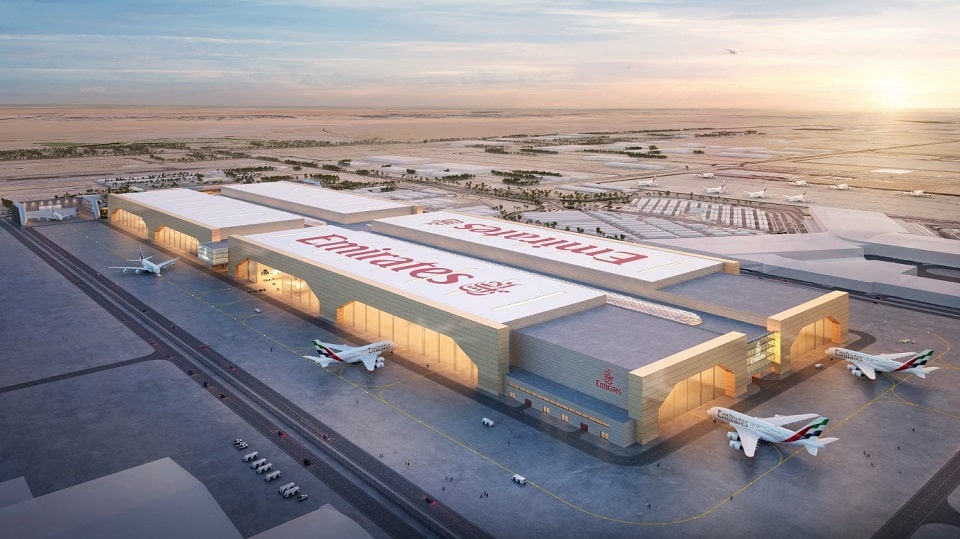Aerospace
Emirates Unveils Ambitious $950 Million Engineering Hub in Dubai

Dubai, UAE, November 14, 2023 – Emirates, the world’s largest international airline, has unveiled plans for a substantial $950 million investment in constructing a cutting-edge engineering facility at Dubai World Central (DWC).
Emirates’ investment underscores the global significance of the new engineering facility.
Spanning an expansive 1 million square meters, this engineering complex is set to be unparalleled in size and sophistication, positioning itself as the foremost facility of its kind operated by any airline globally. This initiative will significantly enhance Dubai’s already top-tier aviation infrastructure.
Key Points:
- Investment Amount: Emirates is allocating a substantial $950 million for the construction of the new engineering facility.
- Location: The facility will be situated at Dubai World Central (DWC), strategically chosen to support Emirates’ operational needs.
- Operational Enhancement: The engineering facility aims to bolster Emirates’ operational efficiency and cater to the evolving requirements of its aircraft fleet.
- Global Significance: As the world’s largest international airline, Emirates’ investment underscores the global significance of the new engineering facility.
Dubai’s Skyline Soars with Emirates’ $950 Million Aviation Marvel
Tailored to meet the evolving needs of Emirates‘ aircraft fleet and operations until the 2040s, the facility is engineered to establish self-sufficiency in maintenance, repairs, overhaul (MRO), and all other engineering requirements. Beyond serving Emirates exclusively, the facility is poised to become a center of excellence for commercial aviation engineering services in the Middle East, with the potential capacity to accommodate other airline operators.
Emirates’ new engineering facility is designed to offer a comprehensive suite of specialized aircraft engineering services, encompassing routine aircraft checks, bespoke paint jobs, light to heavy maintenance programs, engine repair, and testing, as well as full cabin interior fit-outs and aircraft conversions.
Construction for Phase 1 is anticipated to commence in 2024, with completion expected in 2027. The facility’s design incorporates sustainability features, such as the use of green building materials, installation of solar panels, and the implementation of recycling systems for oils and wastewater.
Phase 1 will deliver eight maintenance hangars and one paint hangar, all capable of accommodating commercial aircraft of any size up to Code F (A380). Additional facilities include an engine run-up facility, approximately 20 support workshops, extensive storage facilities, and administration offices.

Aerospace
Boeing Transfers Rocket Stage to NASA, Paving Way for Human Moon Mission

Boeing has achieved a significant milestone by providing NASA with the second core stage of the Space Launch System (SLS) rocket.
This crucial component, crafted at NASA’s Michoud Assembly Facility (MAF), is set to propel the Artemis II crew into lunar orbit, marking humanity’s return to deep space after a 50-year hiatus.
The monumental Boeing-built rocket stage, the largest element of the Artemis II mission, will embark on a journey aboard the Pegasus barge, traveling 900 miles to NASA’s Kennedy Space Center.
Comparison of two legendary aircraft B777x vs B747 aircraft:Click here
Upon arrival, it will be meticulously integrated with other essential Artemis II components, including the upper stage, solid rocket boosters, and NASA’s Orion spacecraft within the iconic Vehicle Assembly Building. This intricate integration process is a vital step toward the eagerly anticipated Artemis II launch, slated for 2025.
“Boeing-built products helped land humankind on the moon in 1969, and we’re proud to continue that legacy through the Artemis generation,” remarked Dave Dutcher, vice president and program manager for Boeing’s SLS program. “Together, with NASA and our industry partners and suppliers, we are building the world’s most capable rocket and paving the way to deep space through America’s rocket factory in New Orleans.”
NASA, Lockheed Martin Reveal X-59 Quiet Supersonic Aircraft:Click here
The delivery of Core Stage 2 marks a significant achievement in the evolution of the SLS rocket. Towering over 200 feet and powered by four RS-25 engines, this core stage, coupled with two solid-fueled booster rockets, will generate a staggering 8.8 million pounds of thrust. This immense power is crucial to launching Artemis II and future missions into the vast expanse of space.
The SLS rocket stands unparalleled in its capability to transport both crew and substantial cargo to the moon and beyond in a single launch. Its extraordinary capacity will facilitate the delivery of human-rated spacecraft, habitats, and scientific missions to destinations including the moon and Mars, ushering in a new era of space exploration.
-

 Travel1 week ago
Travel1 week agoAir India to Expand US Operations with Three New Routes After a Decade
-

 Travel2 weeks ago
Travel2 weeks agoWhy We Should Avoid These Stamps in a Passport
-

 Airlines1 month ago
Airlines1 month agoInvestigations Reveal Fake Chinese Titanium in Boeing and Airbus Jets
-

 Tech4 weeks ago
Tech4 weeks agoChina’s CATL Plans 1,800-Mile Electric Plane Launch by 2027
-

 Airport3 days ago
Airport3 days agoTop 10 Largest Airports in the World by Size
-

 Aerospace4 weeks ago
Aerospace4 weeks agoChina’s Fighter Jets Turn Wings into Autonomous Drones
-

 Airlines4 days ago
Airlines4 days agoAir India Rolls Out A350s for Delhi-New York JFK and Newark Routes
-

 Defence3 weeks ago
Defence3 weeks agoBoeing Enhances Chinook with New Engines and Block II Upgrades at $96 Million







